|
Edited by Frank R. Shaw, FSA Scot, Greater Atlanta, GA, USA
Email: jurascot@earthlink.net
This week, Robert Burns Lives! attains its
250th number. Its founder, Frank Shaw, whom we are proud to call a
friend, has been editing it for much longer than any other current
editor of a Burns-related periodical, and under his benign direction it
has come to occupy a unique position among the several different
periodicals and websites devoted to Robert Burns and the Burnsian
community. Over the past fifteen years, the 250 articles have covered a
remarkable variety of aspects of Burns. They have been contributed by an
equally remarkable range of writers from Alex Salmond (no. 40, 2009),
Ross Roy (repeatedly, from no. 6, 2003) and Eddie Reader (no. 37, also
2009), through virtually every prominent Burns scholar of the past forty
years, to essays from Burns's Ukrainian translators, and even a few non-Burnsians
like David Shi, president of Furman University. They have been linked by
Frank’s own enthusiasm and curiosity, building a community of interest
in the broader significance of Robert Burns and what he means in the
21st century. These things don’t just happen by themselves, and it seems
worth saying thank you.
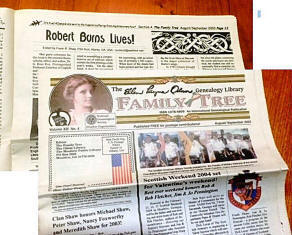
Frank (as we all know him) started Robert Burns Lives! in print as a
column in The Family Tree in September 2002, and it soon became
available also on the web as part of Alastair McIntyre’s site Electric
Scotland. Publication on the Electric Scotland site, with its own front
or index page, gave Robert Burns Lives! more of its own identity as well
as wider distribution. It reached article 50 in April 2009, article 100
in November 2010 (Frank himself writing on the centenary of the Atlanta
Burns Cottage), article 150 in August 2012 (a tribute by Bill Dawson),
and article 200 in July 2014. To celebrate that 200th number, Alastair
McIntyre wrote an excellent retrospective, giving the history of Robert
Burns Lives! with extracts both from the articles themselves and from
Frank's characteristic and generous introductions.
.
In many ways, Robert Burns Lives! is an exemplary story of how its
editor has successfully transitioned through, and his publication has
benefitted from, wider changes in how we all communicate. It began in
print, and moved to digital publication, shedding its early dependence
on subscriptions and mail distribution, and gaining flexibility in
article length and publication schedule and frequent colour
illustration. In digital-only form, Robert Burns Lives! is free and
accessible immediately on publication day to readers worldwide. But
Frank’s willingness to adapt to technological change is only part of
RBL’s success. From the beginning Frank has sought out contributors
personally. When he met someone at a conference, or heard a good
speaker, or read an interesting book and could track down its author, he
has asked them to contribute. As Ross Roy used to do, he has encouraged
young scholars to share accounts of their research, and so begin the
healthy process of engaging with a wider public. And he has written
himself, when books or news items or things he saw in his travels with
Susan caught his attention. Almost everything he has published is
notably more readable than what commonly appears in academic journals,
and it is made even more readable by his introductory comments on the
contributors and their topics. Some of the items on Robert Burns Lives!
have been chiefly of immediate interest, but a remarkable number of the
250 are clearly of lasting value.
For this 250th number, instead of repeating the story told in Alastair's
excellent article three years ago, four of us who are editors of other
Burns-related publications asked Frank if we could mark the occasion by
trying to pin down how Robert Burns Lives! has changed editorial
attitudes and broadened horizons for all periodicals serving the Burns
community. The publications we edit are the annual Burns Chronicle,
edited by Bill Dawson for the Robert Burns World Federation, the
longest-running Burns periodical in the world, which also carries each
year the biggest concentration of research-based articles on Burns; its
bimonthly counterpart, and the newest of Burns periodicals, the RBWF
Newsletter, edited by Mike Duguid, which gives timely illustrated
reports of Burnsian activities; and the two leading academic journals in
Scottish literature, both now appearing twice a year, Scottish Literary
Review, edited by Gerry Carruthers of the University of Glasgow, and
Studies in Scottish Literature, jointly edited by Patrick Scott and Tony
Jarrells of the University of South Carolina. All four of the journals
now have, in different ways as noted below, a digital existence as well
as one in print or hardcopy, a development for which Robert Burns Lives!
and Electric Scotland showed the way.
On the academic end, of course, there are many other journals that
occasionally carry the odd Burns article, and with Web publication, and
now social media, there are several other interesting Burns sites that
also give Burns news (such as the RBANA Newsletter) or even quite
substantial articles; the Glasgow Centre for Robert Burns Studies, for
instance, hosts a site Editing Burns for the 21st Century, with news and
discoveries from the team working on the new Oxford Edition of Robert
Burns. The ASLS’s online e-zine, The Bottle Imp, has Burns articles and
reviews from time to time. Newsletters and websites maintained by
individual clubs provide an increasing variety of substantive content as
well as news; examples are the articles on the Irvine and Calgary Burns
Club sites. But the four journals discussed here represent a full
spectrum from heavily-documented research articles on specific poems or
aspects of Burns’s life to the briefer reports about Burns discoveries,
events and people. This is the spectrum of interest that through Robert
Burns Lives! Frank Shaw has extended and made into a worldwide community
of readers. All four of us have ourselves contributed articles to Robert
Burns Lives!, and the brief reflections and tributes below attempt to
say what Frank’s success with it has meant to us and to Burns studies.
In addition to Robert Burns Lives!, the
Electric Scotland site has extensive Burns content, from early editions
and biographical sources to presentations on Burns localities and recent
talks (indexed at:
http://www.electricscotland.com/burns/index.html)
The Burns Chronicle
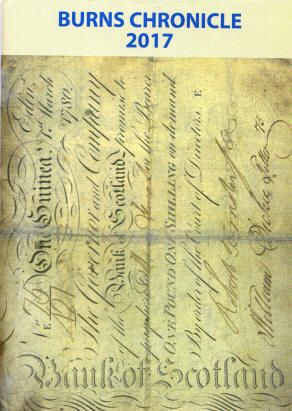
Editor: Bill Dawson. Annual, published each
November dated for the following year. Founded 1892 as Annual Burns
Chronicle and Club Directory. Published by the Robert Burns World
Federation. Approx. 150 pages, hardbound. Current volumes distributed to
Clubs, individual members of the Burns Federation, and subscribing
libraries. Open-access digital version of earlier volumes in progress
at:
http://www.rbwf.org.uk/digitised-chronicles/.
Bill Dawson writes: I am quietly jealous and envious of Robert Burns
Lives! The Burns Chronicle issues one volume annually, with a process
from copy to publication that occupies many weeks, whereas Frank can
publish his articles almost immediately. Robert Burns Lives! can respond
quickly to exciting research developments, where any follow-up in the
Chronicle must wait for a later annual volume. I’m very conscious, from
work on my Index to the Chronicle, of its 126-year-long heritage as the
journal of record for Burns research. When it began publication in 1892,
the authorities of the Burns Federation aimed to publish “interesting
contributions from Burnsian scholars of prominence and recognized
ability.” This is still our goal, more than ever. In the words printed
on our cover: “The mission of the Chronicle remains the furtherance of
knowledge about Robert Burns and its publication in a form that is both
academically responsible and clearly communicated for the broader
Burnsian community.” The volume also, of course, still includes a brief
concluding section maintaining the Federation’s historical record, but
much of the Club news is now shared through the RBWF Newsletter
described below. Many older volumes have been made available in digital
form, though the Chronicle remains primarily a print journal, acquired
for its long-term value by many libraries. Each volume now typically
includes some 15-20 articles about Burns, including articles by
knowledgeable Federation members as well as from academics able to write
for our readership. We have a formal refereeing process for articles by
university-based scholars who request it, and on all articles I can
consult the Chronicle’s advisory board members or other senior scholars,
but for me, as for Frank, the primary test for inclusion is whether an
article meets our criteria of quality, significance, readability, and
interest.
Robert Burns Lives! has provided a model in these developments with its
range of interesting articles and its ever refreshing panel of
contributors. Having been a reader of RBL! long before I became Editor
of the Burns Chronicle, the range of articles and scope of contributors
that Frank has garnered to his column certainly indicated the field of
reference I should engage when I seek potential contributions for the
Chronicle. The exclamation mark on the title, exclaiming Robert Burns
Lives!, is no false boast, supported by a constant flow of interesting
articles about up to the minute fresh research and thought on all
aspects of the life and works of the Poet. I congratulate Frank Shaw on
this remarkable milestone chapter, and I will follow the future progress
of this seminal publication with, in the best and most positive way,
continuing editorial jealousy.
Robert Burns World Federation Newsletter
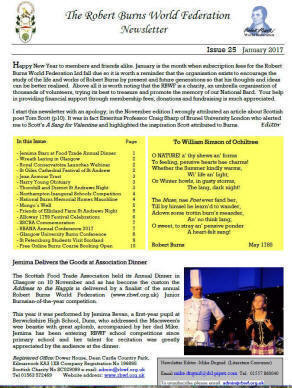
Editor: Mike Duguid. Bimonthly, six issues a
year, January-November. Founded January, 2013. Published by the Robert
Burns World Federation. 12 double-column pages an issue, normally
distributed in pdf by email to Federation members and others; hardcopy
to members on request. Also freely available through links from the RBWF
website, Club sites, Facebook, etc. Current issue and archive at:
http://www.rbwf.org.uk/aboutrbwf/newsletter/.
Mike Duguid writes: From 2002 until 2013 the Burns Chronicle was
published by the Robert Burns World Federation in three printed editions
per year. For some time there had been a discussion about reverting to
the traditional annual format, and the new Editor, Bill Dawson, was keen
to see the Chronicle published in this format so more substantial
articles could again be included. The dilemma was that the Chronicle
also contained club news including notice of, and reports on, events
which would have been difficult to convey in an annual publication. As
Convenor of the Federation’s Literature Committee, I suggested a
bi-monthly Newsletter as a possible solution to this problem especially
as it could be distributed electronically to members and others, thereby
alleviating the perennial problem suffered by the printed Chronicle:
many individual club members never seeing a copy unless a diligent club
secretary circulated it. Since its launch in January 2013, the
Newsletter has become an indispensable form of communication with
members and with the wider public who engage with it through other
social media formats such as the RBWF website and Facebook page. Printed
copies were also made available to those members who didn’t have access
to an electronic mode of communication. The Newsletter, now a standard
12 pages in length, carries an eclectic mix of articles on all aspects
of the Federation’s activities and in particular strives to include as
many items from overseas to reflect the international appeal of Burns.
As Editor of the Newsletter I should like to pass on my congratulations
to Frank Shaw on the publication of the 250th article in the ‘Burns
Lives’ series, a magnificent milestone. As the number of inputs has
grown these readily-accessible articles now cover such a wide spectrum
of topics that there is inevitably something of interest to satisfy
anyone looking for information about Robert Burns. The inspiring writing
from so many accomplished scholars and Burns’ enthusiasts can only but
stimulate further research into the life and works of Scotland’s
National Bard and hopefully encourage even more contributors to pitch
their hats into the ring with this wonderful resource. Lang may yer lum
reek, Frank.
Scottish Literary Review
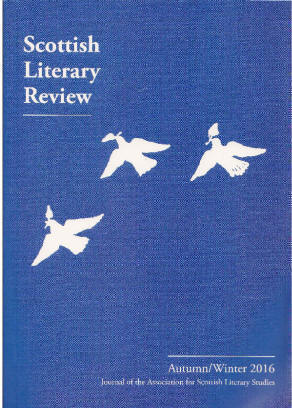
Editor: Gerard Carruthers. Two issues each
year. Founded as Scottish Literary News, 1970-1974; as Scottish Literary
Journal, 1974-2000; as Scottish Studies Review, 2001-2007; current title
from 2008. Published by the Association for Scottish Literary Studies.
Approx. 80-100 pages per issue. Published in hardcopy for ASLS members
and libraries by subscription; also available in digital form from vol.
5 (2013) in many academic libraries through Project Muse:
https://muse.jhu.edu/journal/614.
Gerry Carruthers writes: It is an astonishing feat that Robert Burns
Lives! is reaching its 250th issue, and has never been less than
interesting in all its features. In part, this has to do with its wise
editor having a strong sense that all parts of the very wide Burnsian
church ought to be catered for. Scholars, enthusiast, collectors,
club-members (sometimes all of these things at the same time!) have
contributed to RBL, with a series of cutting-edge, research-led,
critically-thoughtful articles. Remarkably, if anything, RBL’s frequency
of output has sped up since its inception in 2002. Cheering also is the
way that the print journal, the Burns Chronicle (organ of the Robert
Burns World Federation), has worked symbiotically with RBL sharing
themes and sometimes material. This is testimony to the energy,
enthusiasm and charm of RBL’s editor Frank Shaw, similar qualities to
those possessed by Burns Chronicle editor, Bill Dawson. In print and
online Burnsians have never been better served by this network of
cooperation.
As a Burns scholar myself and since 2014 editor of the peer-reviewed,
Scottish Literary Review (organ of the Association for Scottish Literary
Studies), I welcome Burns material, as well as from all areas of
Scottish Literature. The same can be said for my counterparts in the US
who edit, Studies in Scottish Literature; and like my counterparts I
have to be careful not to be too Burns-heavy. What a good thing that I
can often recommend RBL as an outlet to some would-be contributors to
SLR, and RBL (along with SSL) has also encouraged me to introduce
shorter notes and articles in relation to Burns, especially but not
exclusively on matters of Burns publishing and manuscript history. My
own journal, SLR, is part of a scholarly landscape where discussion of
Burns is suitably energetic and dynamic for the twenty first century. It
is an unalloyed pleasure to salute Robert Burns Lives and, indeed, its
editor. Frank, here’s to your next 250 issues!
Studies in Scottish Literature
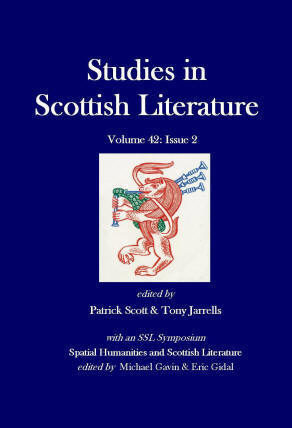
Editors: Patrick Scott and Tony Jarrells.
Two issues each year. Founded by G. Ross Roy, 1963, and edited by him
through vol. 35-36, 2007. Refounded 2012. Published by University of
South Carolina Libraries. Approx. 150 pages per issue, or 300 pages a
year. Recent issues (and vols 37-41) are published in print-on-demand
paperback through CreateSpace, Amazon and Amazon UK, and in open-access
digital form (vols 1-42, 1963-20) at:
http://scholarcommons.sc.edu/ssl/.
Patrick Scott writes: When Ross Roy founded Studies in Scottish
Literature, there was no recognized scholarly journal dedicated to
Scottish literary studies. The early success of the journal was one of
the factors that made sniffy academics in adjacent literary fields
acknowledge the emergence of Scottish literature as an academic
discipline. SSL tries to include articles from the whole range of
Scottish literary history, from medieval poetry to 21st century crime
fiction, but Ross’s own research and collecting interests ensured that
over the years it regularly published Burns articles, research notes,
and reviews. He was specially proud of the all-Burns volume 30 (1998),
with illustrations by Alasdair Gray, that printed the talks from the
South Carolina Burns bicentenary conference. The first “new” volume
after we took over was a collection of Burns essays in Ross’s honor, and
the five volumes we have edited since then have all included Burns
items, a reflection of growing research activity in the field.
Nonetheless, even over a period of sixty years, out of the 1000 or more
items on our web-site, the Burns items in SSL will probably total closer
to 120 items, than to the 250 that Frank has now published on RBL!.
In 2012, shortly before his death, Ross transferred rights in the
journal to the University, for publication to resume after a nearly
five-year gap. We inherited therefore (indeed had thrust upon us) a
goodly heritage, but a difficult situation. Print subscriptions had
declined over the years, and SSL had already missed its best opportunity
to add a subscription-based digital version. The obvious success of
Robert Burns Lives! was one of the things that encouraged us to restart
the journal in open-access form, and to make the back volumes similarly
available. Total full-text article downloads since 2012 have now passed
the 200,000 mark, with a range of readership that was never possible
when we were solely dependent on print distribution. Editing for an
academic journal is inevitably more formal and impersonal (and slower!)
than Robert Burns Lives! The ambitious young birkies of academic life
need the guinea-stamp of refereed publication, even though as editors we
are all looking primarily for the pith o’ sense. To maintain
professional recognition, all SSL’s full-length articles go through a
formal review process (often as helpful to the writers as to the
editors); we keep the page format on the screen as that of a traditional
print journal, with extensive documentation; and we still produce a
print-on-demand hard-copy to ensure future availability in traditional
libraries. But, alongside the traditional research articles, we have
tried also to incorporate some of the proactive flexibility that
characterizes Frank as editor. Our new volumes typically start with a
group of invited articles giving varying perspectives on a single topic,
just as Robert Burns Lives! has done successfully with Burns and
slavery, Burns and sex, and Burns and medicine. We are including many
more illustrations, most notably in our ongoing series of shorter notes
researching the Burns manuscripts in the Roy Collection. To provide
timely positive coverage of new books, we write shorter descriptive
notices in-house, with formal full-length expert reviewing now reserved
for a few selected items. And we’ve recently split the annual volume
into two shorter issues a year, to shorten publication delays. No doubt,
as with other academic journals, there will be further changes to SSL in
the coming years.
Soon after SSL’s first number appeared, when Ross was still teaching in
Texas, the Aberdeen Press and Journal newspaper reviewed it, to his
great joy, under the bold-print headline “Texas Shows the Way to
Scotland.” Frank Shaw and Robert Burns Lives! have shown the way to
other editors on how to serve and interest and inform a broad-based
community of Burnsians. Each of our four journals has its particular
mission or niche and strengths that differentiate it from Robert Burns
Lives!, but Frank’s achievement has enriched us all. Thanks to you,
Frank, from all of us as you reach this milestone. |
